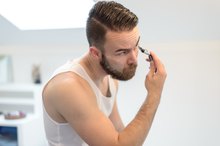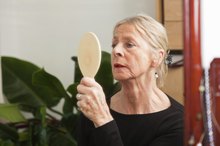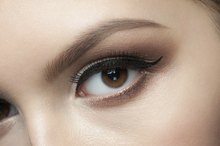What Is the Normal Age to Start to Shave?
Boys and girls start to grow hair in new locations during puberty, which varies drastically from person to person. Girls usually enter puberty between 8 and 13 years of age while boys start puberty between 10 and 15 years of age.
Significance
During the onset of puberty, many body changes occur in both boys and girls. These changes typically coincide with other secondary sexual characteristics, including growth spurts, voice changes and the development of sexual organs. Shaving new hair is not essential, though many parents will help their child learn to shave new hair in an effort to become comfortable with the changes in their body.
- During the onset of puberty, many body changes occur in both boys and girls.
- These changes typically coincide with other secondary sexual characteristics, including growth spurts, voice changes and the development of sexual organs.
Girls
Underarm Hair in Girls
Learn More
Most girls enter puberty before boys 2. This fact is often obvious by physical appearance, as the associated growth spurt will make pre-teen girls appear larger than boys. At the same time, however, the pubescent girl begins to grow hair under her arm and on her legs. These areas are typically the first that the girl will begin to shave, at some point after the onset of puberty.
- Most girls enter puberty before boys 2.
- This fact is often obvious by physical appearance, as the associated growth spurt will make pre-teen girls appear larger than boys.
Boys
Most boys, on average, begin to grow facial hair around the age of 15. Teenage boys typically will begin to shave their face in the years following onset of puberty. Often in the first stages of facial hair growth, the fullness of facial hair will not be complete.
Considerations
Hair Growth During Puberty
Learn More
When a child begins to shave, they might experience a skin reaction. Razors can leave skin irritated and dry so it is important to maintain proper cleansing and moisturizing for the shaved areas. Additionally, use of shaving cream or gel will help the child cope with possible adverse skin reactions to shaving. At the beginning, neither boys nor girls usually have to shave every day.
- When a child begins to shave, they might experience a skin reaction.
- Additionally, use of shaving cream or gel will help the child cope with possible adverse skin reactions to shaving.
Warning
Parents or other adults should instruct a child how to shave. Also, new hair growth does not always begin directly after puberty begins. If you are concerned that your child has not yet grown puberty-related hair, consult a physician, but remember that every child develops at his own pace.
Related Articles
References
- KidsHealth.org: All About Puberty
- Young Men's Health Site: Puberty
- KidsHealth.org: Shaving
- Kaplowitz P, Bloch C. Evaluation and referral of children with signs of early puberty. Pediatrics. 2016;137(1). doi:10.1542/peds.2015-3732
- Biro FM, Greenspan LC, Galvez MP. Puberty in girls of the 21st century. J Pediatr Adolesc Gynecol. 2012;25(5):289-94. doi:10.1016/j.jpag.2012.05.009
- Yoo JH. Effects of early menarche on physical and psychosocial health problems in adolescent girls and adult women. Korean J Pediatr. 2016 Sep;59(9):355-361. doi:10.3345/kjp.2016.59.9.355
- Bodicoat DH, Schoemaker MJ, Jones ME, et al. Timing of pubertal stages and breast cancer risk: the Breakthrough Generations Study. Breast Cancer Res. 2014;16(1):R18. doi:10.1186/bcr3613
- Kim EY. Long-term effects of gonadotropin-releasing hormone analogs in girls with central precocious puberty. Korean J Pediatr. 2015 Jan;58(1):1-7. doi:10.3345/kjp.2015.58.1.1
- Wojniusz S, Callens N, Sütterlin S, et al. Cognitive, emotional, and psychosocial functioning of girls treated with pharmacological puberty blockage for idiopathic central precocious puberty. Front Psychol. 2016;7:1053. doi:10.3389/fpsyg.2016.01053
- Schoelwer M, Eugster EA. Treatment of peripheral precocious puberty. Endocr Dev. 2016;29:230-9. doi:10.1159/000438895
- Franzini IA, Yamamoto FM, Bolfi F, Antonini SR, Nunes-nogueira VS. GnRH analog is ineffective in increasing adult height in girls with puberty onset after 7 years of age: a systematic review and meta-analysis. Eur J Endocrinol. 2018;179(6):381-390. doi:10.1530/EJE-18-0473
- Olson-kennedy J, Chan YM, Garofalo R, et al. Impact of early medical treatment for transgender youth: protocol for the longitudinal, observational trans youth care study JMIR Res Protoc. 2019;8(7):e14434. doi:10.2196/14434
- Yoon JW, Park HA, Lee J, Kim JH. The influence of gonadotropin-releasing hormone agonists on anthropometric change in girls with central precocious puberty. Korean J Pediatr. 2017;60(12):395-402. doi:10.3345/kjp.2017.60.12.395
- Pienkowski C, Tauber M. Gonadotropin-Releasing Hormone Agonist Treatment in Sexual Precocity. Endocr Dev. 2016;29:214-29. doi: 10.1159/000438893.
- Thornton P, Silverman LA, Geffner ME, Neely EK, Gould E, Danoff TM. Review of outcomes after cessation of gonadotropin-releasing hormone agonist treatment of girls with precocious puberty. Pediatr Endocrinol Rev. 2014 Mar;11(3):306-17.
- Fuqua JS. Treatment and outcomes of precocious puberty: an update. J Clin Endocrinol Metab. 2013 Jun;98(6):2198-207. doi: 10.1210/jc.2013-1024.
Writer Bio
Erik Andrews began scientific and medical writing in 2004. His work as a second author on a research article appeared in the journal "Genetics" in 2005. His areas of expertise are the natural sciences, medical education and physical fitness. He earned a Master of Science in chemistry and a Bachelor of Arts in biochemistry, both from the University of Pennsylvania.









